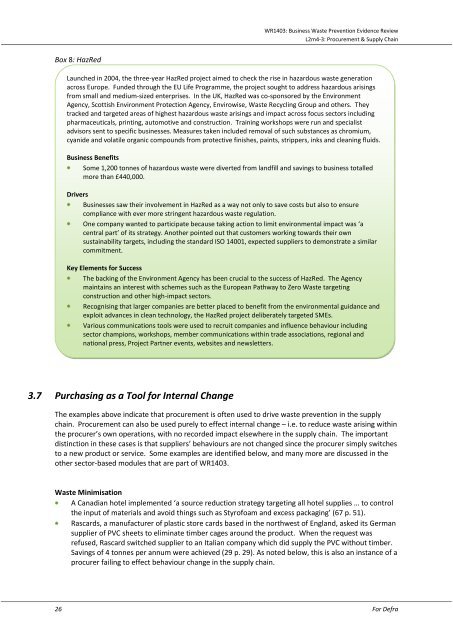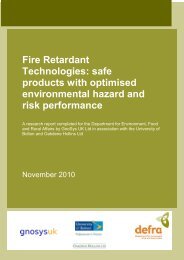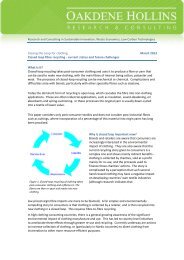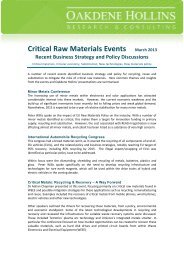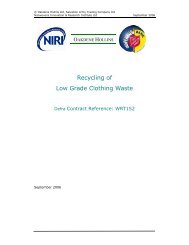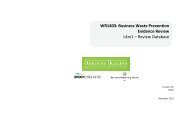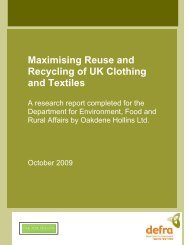Procurement and Supply Chain - Oakdene Hollins
Procurement and Supply Chain - Oakdene Hollins
Procurement and Supply Chain - Oakdene Hollins
Create successful ePaper yourself
Turn your PDF publications into a flip-book with our unique Google optimized e-Paper software.
WR1403: Business Waste Prevention Evidence Review<br />
L2m4-3: <strong>Procurement</strong> & <strong>Supply</strong> <strong>Chain</strong><br />
Box 8: HazRed<br />
Launched in 2004, the three-year HazRed project aimed to check the rise in hazardous waste generation<br />
across Europe. Funded through the EU Life Programme, the project sought to address hazardous arisings<br />
from small <strong>and</strong> medium-sized enterprises. In the UK, HazRed was co-sponsored by the Environment<br />
Agency, Scottish Environment Protection Agency, Envirowise, Waste Recycling Group <strong>and</strong> others. They<br />
tracked <strong>and</strong> targeted areas of highest hazardous waste arisings <strong>and</strong> impact across focus sectors including<br />
pharmaceuticals, printing, automotive <strong>and</strong> construction. Training workshops were run <strong>and</strong> specialist<br />
advisors sent to specific businesses. Measures taken included removal of such substances as chromium,<br />
cyanide <strong>and</strong> volatile organic compounds from protective finishes, paints, strippers, inks <strong>and</strong> cleaning fluids.<br />
Business Benefits<br />
Some 1,200 tonnes of hazardous waste were diverted from l<strong>and</strong>fill <strong>and</strong> savings to business totalled<br />
more than £440,000.<br />
Drivers<br />
Businesses saw their involvement in HazRed as a way not only to save costs but also to ensure<br />
compliance with ever more stringent hazardous waste regulation.<br />
One company wanted to participate because taking action to limit environmental impact was ‘a<br />
central part’ of its strategy. Another pointed out that customers working towards their own<br />
sustainability targets, including the st<strong>and</strong>ard ISO 14001, expected suppliers to demonstrate a similar<br />
commitment.<br />
Key Elements for Success<br />
The backing of the Environment Agency has been crucial to the success of HazRed. The Agency<br />
maintains an interest with schemes such as the European Pathway to Zero Waste targeting<br />
construction <strong>and</strong> other high-impact sectors.<br />
Recognising that larger companies are better placed to benefit from the environmental guidance <strong>and</strong><br />
exploit advances in clean technology, the HazRed project deliberately targeted SMEs.<br />
Various communications tools were used to recruit companies <strong>and</strong> influence behaviour including<br />
sector champions, workshops, member communications within trade associations, regional <strong>and</strong><br />
national press, Project Partner events, websites <strong>and</strong> newsletters.<br />
3.7 Purchasing as a Tool for Internal Change<br />
The examples above indicate that procurement is often used to drive waste prevention in the supply<br />
chain. <strong>Procurement</strong> can also be used purely to effect internal change – i.e. to reduce waste arising within<br />
the procurer’s own operations, with no recorded impact elsewhere in the supply chain. The important<br />
distinction in these cases is that suppliers’ behaviours are not changed since the procurer simply switches<br />
to a new product or service. Some examples are identified below, <strong>and</strong> many more are discussed in the<br />
other sector-based modules that are part of WR1403.<br />
Waste Minimisation<br />
A Canadian hotel implemented ‘a source reduction strategy targeting all hotel supplies … to control<br />
the input of materials <strong>and</strong> avoid things such as Styrofoam <strong>and</strong> excess packaging’ (67 p. 51).<br />
Rascards, a manufacturer of plastic store cards based in the northwest of Engl<strong>and</strong>, asked its German<br />
supplier of PVC sheets to eliminate timber cages around the product. When the request was<br />
refused, Rascard switched supplier to an Italian company which did supply the PVC without timber.<br />
Savings of 4 tonnes per annum were achieved (29 p. 29). As noted below, this is also an instance of a<br />
procurer failing to effect behaviour change in the supply chain.<br />
26 For Defra


